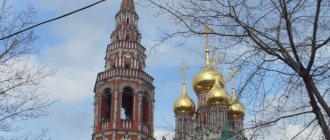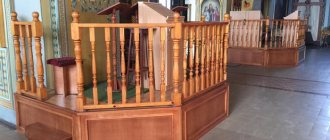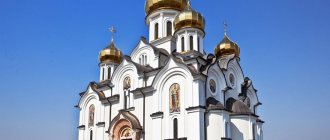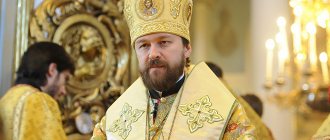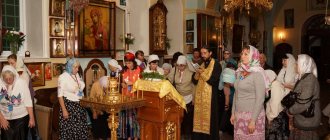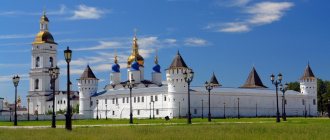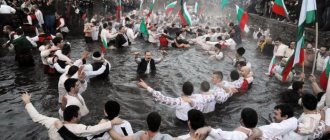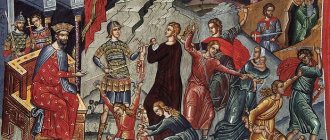Name meaning
Most likely, the understanding should be influenced by the history of the church.
The term itself comes from the Greek language. It means “assembly” (sounds like “ekklesia”). It is very interesting that it was not the building that was originally called that. This term denoted the believers themselves. Therefore, the church is a community of believers, in our case, Christians. If you read the New Testament, you can penetrate deeper into the meaning of our term. It says that the church is a temple. But not the building! This is the dwelling place of the Holy Spirit! And, as you know, it is intangible. The Holy Spirit is found where he is revered. Anyone whom he helps in life, who believes and hopes, has him in his heart. The New Testament calls such people brothers in Christ. The meaning of this understanding of the church is contained in the “Creed” prayer. She says that the church is a community of people united by common aspirations of the soul. They have the same attitude towards the teachings of Christ, understand and live according to its laws!
Etymology[ | ]
In Russian, as in most Slavic languages, the term "church" goes back to the Greek adjective Κυριακόν, "Lord's" (belonging to the Lord), from which the name of the church in Germanic languages also comes. According to Vasmer, before entering the Slavic languages, the word passed through the Germanic languages[1]. However, in the Greek Christian tradition, including the New Testament and Patristic tradition, the church is designated by the word Greek. Ἐκκλησία (ekklesia), “assembly” (translation into Greek Ancient Hebrew קהל [kagal] “assembly” from Scripture), directly to which the name of the church in Latin goes back, among most peoples of the Romance language group, Welsh, Armenians, Georgians, as well as among the Turks and Arabs.
From the word Ἐκκλησία also comes the name of ecclesiology - a section of Christian theology that covers issues related to the church.
Bible about the church
The thought already voiced is confirmed by the Holy Book. It states that ordinary believers are neither aliens nor strangers. On the contrary, they are called fellow citizens of the saints and members of God! It is clear that this statement does not apply to everyone. We are now confident that the performance of rituals and irregular visits to church give the right to the Kingdom of God. Is it so? The Bible plainly says “having Jesus Christ Himself” as the cornerstone.
You need to understand this quote with your soul. It is in it that the criterion for such a concept as the “Church of God” is found. A believer is not one who observes traditions, knows a lot and follows the rules established by religion purely outwardly. The words “Christ is the cornerstone” suggest that a Christian builds his worldview on his teaching. The commandments underlie his thoughts, and therefore his actions and deeds. Such people constitute God's Temple on earth. The Church, according to the Bible, is one. It is called universal. It consists of congregation-based denominations. The latter, in turn, are also called churches.
Main denominations
We have already said that there are denominations of the universal church on earth. We know them as Catholicism, Orthodoxy and Protestantism. These are all currents of Christianity. Each of them is also called “Church,” meaning associations of local communities. It so happens that these communities are now geographically intertwined. In almost all countries and regions there are representatives of one church or another. However, these people constitute, so to speak, a monolithic society, united by spiritual bonds. They have one God in their souls, they strive for him, and consider him the criterion of their own thoughts and deeds. By the way, representatives of one church consider it their duty to lend a shoulder to their fellow tribesmen. Strange, isn't it? And what did Christ teach to divide people according to confessions? A true Christian will not refuse support to anyone based on differences of opinion. Unfortunately, the history of the church provides us with many examples when believers waged religious wars among themselves.
Church
Post a biography, about the company, services[en]
Church Church holidays and events / Civil holidays / Events / Surnames / Horoscopes / Tests / Namesakes / First names / Patronymics / First name and patronymic / Home
Church
(from the Greek kyriake (oikía) - “God’s house”. Further in the text - “Ts.”):
1) Christian temple Temple
- a religious building for performing religious rituals. The construction of temples began in ancient times (ancient oriental, ancient temples).
The main types of temples are Christian church, Muslim mosque, Buddhist temple..
2) In extended usage - an organization of followers of a particular religion Religion
(from the Latin religio - piety, shrine, object of worship) - worldview and attitude, as well as corresponding behavior and specific actions (cult), based on belief in the existence of a god or gods, the supernatural. Historical forms of development of religion: tribal, national-state (ethnic), world (Buddhism, Christianity, Islam). based on a common belief and cult.
3) A building for worship in Christianity. Throughout the centuries-old history of Christianity, Christianity
- one of the three so-called world religions (along with Buddhism and Islam).
It has three main directions: Orthodoxy, Catholicism, Protestantism. It is based on faith in Jesus Christ as the God-man, the Savior, the incarnation of the 2nd person three among different peoples. The people
are the population of the state, a single socio-economic and political community, regardless of division into national communities.
In a general sense, the concept of “people” means a national-cultural community isolated from others, the boundaries of which usually do not coincide with state borders. In this sense, the term “people” is synonymous with the concepts of “nation” or “ethnic community”. Various types of churches have developed, consisting of, at a minimum, an altar part (Altar), oriented to the east, and an adjoining room for worshipers. More often, a church is a complex of many interconnected parts (Capella Chapel
(Late Latin capella) - a Catholic or Anglican chapel: a small separate building or room in the temple (in the side nave, around the choir) for the prayers of one family and the storage of relics.
In music, a chapel is a choir of singers (from the name of the chapel or church aisle where the choir sang); a group of instrumental performers. Since the 18th century there has also been a mixed ensemble of singers and musical instrument performers., Krypta Krypta
(from the Greek crypta - covered underground passage, hiding place):
1) In Ancient Rome - any vaulted underground or semi-underground room.
2) In medieval Western European architecture, a chapel under a temple (usually under the altar), used as a place for honorary burials. K. were widespread in the architecture of the early Middle Ages., Chapel
(in an Orthodox church) - an extension from the southern (or northern) facade or a specially designated part of the main building, which has an additional altar for individual services., Refectory).
The main Christian church of a city or monastery is called a cathedral. Cathedral
- in religious architecture, a cathedral is the name given to the main church of a city or monastery, where the highest clergy (patriarch, archbishop) officiates. The architecture of the cathedral is usually distinguished by its monumental forms and reflects the trends of the dominant architectural style of its time.
The most famous are the cathedrals of Notre Dame in Paris, St. Peter in Rome, St. Paul in London, St. Sophia Cathedrals in Kyiv and Novgorod, and Cologne Cathedral in Germany.
In cities there are several cathedrals; a large temple is often called a cathedral. Lutheran churches are usually called kirks or churches, Polish Catholic churches are called churches.
4) Specific to Christianity, the concept of a mystical community of believers (“faithful”), in which the unity of man with God is realized through joint participation in the “sacraments” (primarily the Eucharist Eucharist
(Greek Eucharistia) - the same as communion.). The universal (“ecumenical”), “catholic” (“conciliar”) character of the church as the mystical “body of Christ” and the “fullness of the Holy Spirit” makes it impossible to identify it with any ethnic, political or other community (tribe, nation, state[ en]).
5) In extended usage - an organization of followers of a particular religion based on a common belief and cult.
Article from the mid-20th century:
6) A special type of religious organization, an association of followers of one or another religious movement based on a common belief and cult. The main distinguishing features of the church: the presence of a more or less developed dogmatic and cult system (dogmas Dogmas
in religion - a position of doctrine approved by the highest church authorities, declared by the church to be an immutable truth, not subject to criticism.
Christianity, Islam, Buddhism, etc., have a system of dogmas); hierarchical nature, centralization of management; division of all those belonging to the Church into professional ministers of worship (clergy) The clergy are
ministers of worship in monotheistic religions; persons professionally engaged in the administration of religious rites and services and constituting special corporations. In the Orthodox Church, the clergy is divided into black (monasticism) and white (priests , deacons) and ordinary believers (laity).
In all antagonistic social systems, the church is associated with the ruling classes and performs important political, legal and ideological functions. the State was separated from the state
- in the theory of law, a way of organizing society, the main element of the political system, the organization of public political power, based on means and measures of coercion.
The church finally took shape in the era of feudalism. During this period, it was especially closely connected with the entire state and social structure, acting, as Friedrich Engels noted, “... as the most general synthesis and the most general sanction of the existing feudal system” (F. Engels, see Karl Marx and Engels F., Soch., 2nd ed., vol. 7, p. 361). Church parish Parish
- the lowest church administrative unit, a church with a clergy and the church community (parishioners) that contains them.
In the Russian Orthodox Church, parishes are united into deaneries. was not only a religious, but also a social unit, a kind of neighborhood community. Community
is a form of social organization. The primitive (tribal) community is characterized by collective labor and consumption, the later form - the neighboring (territorial, rural) community combines individual and communal ownership, is characteristic of pre-capitalist society. The community has full or partial self-government.
In pre-revolutionary Russia, the community was a closed class unit, used as an apparatus for collecting taxes (after the Peasant Reform of 1861 - the owner of the land). During the Stolypin agrarian reform, communal land ownership was replaced by private peasant ownership.
Ancient historical communities are also called a community: a city commune, a religious, a professional, a countryman's community... All members of society belonged to the Church .
in a broad sense - a set of historically established forms of joint activity of people;
in a narrow sense - a historically specific type of social system, a certain form of social relations (for example, society opposed to the state in Hegel). (excommunication from the Church was a punishment; everyone who left her was qualified as “heretics.” Heretic
is an adherent of the Heresy.
Heresy
- (from the Greek hairesis - special creed) - in Christianity, movements that deviate from the official church doctrine in the field of dogma and cult.
The greatest development was achieved in the Middle Ages. Among the most significant: the heresies of the Paulicians, Cathars, Waldensians, Lollards, Taborites; in Russia - Strigolnikov. In a figurative sense, a deviation from something accepted in society as undeniable; delusion."). For ordinary parishioners (peasants, artisans), the temple was not only a place for performing rituals. Rites
are traditional actions that accompany important moments in the life of the human community. Rituals associated with birth, wedding, death (see Burial, Initiations) are called family; agricultural and other rituals - calendar, but also a political and social center.
Belonging to a given church in the era of feudalism was based primarily not on conscious choice, but on family and national traditions Tradition
(from the Latin traditio - transmission) - elements of social and cultural heritage that are transmitted from generation to generation and preserved in certain societies and social groups for a long time.
Traditions are defined as certain social institutions, norms of behavior, values, ideas, customs, rituals, etc. Certain traditions operate in any society and in all areas of public life. The sects opposed the sect .
(from the Latin secta - teaching, direction, school) - a religious group, community that has broken away from the dominant church. In a figurative sense, it is a group of people who are isolated in their own narrow interests, including people who broke away from it, broke with the dominant religion and acted, as a rule, from the position of rejection of the existing system (sectarianism). Most sects, unlike the Church, were formed primarily on the basis of individual conscious entry into them.
Under capitalism, the position of the church (as well as other religious organizations) has changed significantly. It lost its monopoly in various areas of mental activity, in a number of countries (France, USA[en], etc.) it separated from the state and lost its former legal functions. “Religious pluralism” emerged, in which legally equal religious organizations competed with each other; in the field of religion, the individual was given a certain freedom of choice, masking the connection of religious organizations, and primarily the Church, with the ruling class.
Capitalist industrialization and urbanization changed the face of the primary church community: the gap between the place of work and the place of residence, increased social and territorial mobility of the population, the spread of religious indifference and free-thinking - all this changed the previous role of the parish.
A religious group under capitalism did not coincide with any other social communities. Many believers perceive their affiliation with the church formally. The differences between churches and sects are being erased. The center actually ceases to include the entire population; many sects become widespread, losing their former closed character; their condemnation of the existing world order is often replaced by its complete acceptance.
In the photo: construction of the temple-monument “Ascension of the Lord” in the city of Ivanovo
Video: Chapel of St. Nicholas the Wonderworker in the Holy Handle tract, Crimean region, Krasnodar region
The chapel in the name of St. Nicholas was erected in 1993-1998 by the diligence and labors of the Greek communities of the Krasnodar region on the initiative of Kiriak Iraklievich Orfanov (Georgios Kaimos) and the ataman of the suburban kuren Boris Dmitrievich Yastrebov with the Cossacks on donations from Orthodox Christians.
A large brick chapel with a cruciform plan and a free-standing bell tower. Built in 1994 by the Cossacks and the Greek diaspora of the Krasnodar region, the inside was painted by Greek and Russian artists. In 1999, it was transferred under the spiritual management of the Church of St. Michael the Archangel in Krymsk.
Video: church bell ringing
Largest Christian churches: Orthodox Orthodoxy
- one of the main and oldest trends in Christianity.
It arose with the division of the Roman Empire into Western and Eastern in 395. The theological foundations were determined in Byzantium in the 9th-11th centuries. It finally emerged as an independent church in 1054 with the beginning of the division of the Christian Church into Catholic and Orthodox. Gradually it divided into several autocephalous churches. In Rus' since the end of the 10th century (see Baptism of Rus'), since 1448 the Russian Orthodox Church. In the Russian Federation, Orthodox Christians make up the majority of believers. church (consisting of autocephalous churches), Catholic (Catholicism), Armenian Apostolic Church, Protestant churches (Anglican Church, Lutheran Church, Calvinist Church). In Protestantism, many sects transformed into the Church. (Methodists Methodists (
Methodist Church) is a Protestant church, mainly in the USA and Great Britain. It arose in the 18th century, separating from the Church of England, demanding consistent, methodical observance of religious precepts. Methodists preach religious humility, patience., Baptists, Mennonites).
In Confucianism, Buddhism Buddhism
- one of the three (along with Christianity and Islam) world religions.
Originated in Ancient India in the 6th-5th centuries. BC e., Judaism has not developed such a clearly defined corporate centralized church organization as in Christianity (although there is a hierarchy of clergy in some of them), because these religions first of all declare the identity of the civil and religious communities, fundamentally rejecting the very idea of their separate existence (and therefore an autonomous religious group represented by Ts.). (D. M. Ugrinovich)
On July 16, 1054, a split in the Christian Church occurred, as a result of which the Roman Catholic Church separated from the Orthodox Church.
On March 6, 1722, a Decree of Peter I was issued, prohibiting collections in the Russian Empire for the construction of churches and the needs of the church.
| "Prayer", Spanish V. Obodzinsky |
| “Cherubic Song”, P. Tchaikovsky |
| "Prayer", Spanish Alexander Gradsky |
On January 5, 2021, Patriarch Bartholomew of Constantinople solemnly signed the tomos of autocephaly of the “Orthodox Church of Ukraine[en].”
- See also: The sanctified time of the Church: the church new year and the peace circle.
- Baptism of the Lord (Epiphany).
- Trinity. Pentecost.
- Church schism.
- Annunciation.
- Ivan Kupala.
- Maslenitsa.
- Memorial service.
- Bible.
- Christmas time.
Did you like the article? Like, comment, share with friends! Get +1 to Karma And leave a comment just below. |
| Subscribe to news: |
Find something else interesting:
Have something to say, add, or noticed a mistake? Share! Someday your children[en]-grandchildren will come here and see a familiar name...
Spam, insults, bad language, SEO links, advertising, disrespectful treatment, etc. prohibited. Violators are banned
.
By clicking the “Submit” button in the comment, I agree to the processing of personal data:
Publish biography, about the company[en] | Thanks for the tip Privacy Policy | Home | Connection
One more division
We have already mentioned that not all believers are actually such. In the teachings of Christ this “phenomenon” is given some attention. That is, we are talking about the visible and invisible church. Meaning also lies deep within a person. The visible church is what a person observes with his own eyes. He judges others by their behavior. However, not everyone who follows the rules and rituals has Jesus as the cornerstone of their soul. You've probably encountered such behavior. This is where we should talk about the invisible church. The Lord will judge anyone not by the regularity of visiting the temple or offering prayers. He will separate real Christians from those who are just pretending, without having Christ in their hearts. This is written about in the New Testament.
It says that among Christians there will be many who are not Christians. They only behave like believers. But everything will be revealed at the Supreme Court. He will reject those who do not have a temple in their souls, who sin, demonstrating truly Christian behavior. But it should be understood that the church is still one. It’s just that not everyone can fully perceive it.
About the temple
Surely you are already confused. If the church is a community of believers, then why do we call a building by this word? We should remember communities of people professing the same religion. Historically, they were organized into communities led by a priest. And he, in turn, serves in a special building. Of course, such a tradition did not form immediately. But over time, people realized that one temple is more convenient than, for example, serving in different buildings alternately, like the Mormons. Since then, buildings have also been called churches. Then they began to build them to stand out, beautiful, symbolic. They began to be dedicated to certain Saints and called by their names. For example, the Church of the Mother of God is an Orthodox church dedicated to the woman who gave earthly life to the Son of God.
Literature[ | ]
- Quotes on Wikiquote
- Vasilyeva E. N.
The Church from the point of view of orthodox and heterodox theology // Almanac of modern science and education. Tambov: “Literacy”, 2007. No. 2 (2): History, anthropology, archeology, ethnography, local history, philosophy, theology, cultural studies, political science, jurisprudence and methods of teaching them. — P. 118-120. - Vasilyeva E.
N. Church and sect: development of scientific concepts. - Saarbrucken: LAP Lambert Academic Publishing, 2011. - 183 p.
| Dictionaries and encyclopedias |
|
| Regulatory control |
|
Religious traditions
Here we come to another interesting question that a reader who has not delved into the topic before may ask. If the church is in the souls of believers, then why go to church? Here it is necessary to remember the teaching of Christ. He said that believers should be active in the local church. That is, everyone decides the affairs of the community together, helps each other, even monitors and corrects in case of mistakes. In addition, we are talking about church discipline. Customs are not established from above, but are inherited from parents to children. Since it was customary to go to church, this is what should be done until society changes its decision.
A little more about the church
One nuance should be added to the above, to which the Law of God draws attention. It says that the church does not only include living believers. Those who have already left this world, but were united in love with their relatives and friends, are also included in the common temple. It turns out that the concept of “church” is much broader than what we see or can feel. Part of it is in another world, another, spiritual sphere. All people, united by the understanding of the need to have Christ in their souls, both living and deceased, make up the church and are its members. The building (cathedral, temple) was created for the convenience of parishioners. The Church is Christians, all or part of them, united by a common hierarchy. We can say that this is a single spiritual body with Christ at its head. It is also illuminated by the Holy Spirit. Its goal is to unite people with Divine teaching and sacraments.
Notes[ | ]
- M. Vasmer. Etymological dictionary of the Russian language. Article "church"
- B. Heavenly triumphant Church - The saving fruits of the resurrection of Christ - The Resurrection of Christ - Part four. God is the Savior of the world - Orthodox Dogmatic Theology (undefined)
(inaccessible link). Access date: May 16, 2013. Archived December 3, 2013. - Church // The New Shorter Oxford English Dictionary (English) Russian. (English) / Lesley Brown. - Oxford: Oxford University Press, 1993. - ISBN 0-19-861134-X. "8. A non-Christian society or movement is regarded as a religion or as having the social, ethical or spiritual qualities of a religion. Example: Church of Scientology
» - Zelenov L. A., Vladimirov A. A., Shchurov V. A.
History and philosophy of science: textbook. - Flint: Science, 2008. - 456 p. — ISBN 978-5-9765-0257-4 - Johann Jakob Herzog, Albert Hauck, Samuel Macauley Jackson, Charles Colebrook Sherman, George William Gilmore.
The New Schaff-Herzog Encyclopedia of Religious Knowledge: Embracing Biblical, Historical, Doctrinal, and Practical Theology and Biblical, Theological, and Ecclesiastical Biography from the Earliest Times to the Present Day.
- Funk and Wagnalls Company, 1969. - T. 3. - P. 75. - 259 p. "An extension has taken place in recognized usage in accordance with which men speak of the Buddhist or the Jewish Church
, meaning the whole body of believers in Buddhist or Jewish teaching." - ↑ 1 2
How to write words related to the church?
(undefined)
.
Reference and information Internet portal “Russian language”
. "Gramota.ru". Date accessed: May 22, 2021. - Valgina N. S., Eskova N. A., Ivanova O. E., Kuzmina S. M., Lopatin V. V., Cheltsova L. K.
Names associated with religion // Rules of Russian spelling and punctuation. Complete academic reference book / Lopatin V.V. - M.: AST, 2009. - 432 p. — ISBN 978-5-462-00930-3. — ISBN 978-5-699-18553-5. - ↑ 12
Lumen Gentium - Declaration of Dominus Iesus on the website unavoce.ru
- The Council of Trent, The Seventh Session, ON BAPTISM, CANON IV
- CATECHISM OF THE CATHOLIC CHURCH Second Section The Seven Sacraments of the Church CHAPTER ONE V. Who can baptize? 1256
- ECUMENICAL COUNCIL OF FLORENCE (1438—1445) Session 8—22 November 1439 (Bull of union with the Armenians)
- Long Christian Catechism of the Orthodox Catholic Eastern Church (adapted edition) // On the ninth article of the Creed (§ 250)
- ↑ 12
Borders of the Church // Orthodox Encyclopedia, vol. 12, p. 265-283 - Protopresbyter Theodore Zisis. Boundaries of the Church and ecumenism
- Kuraev A.V.
, deacon Imaginary modernism (Once again on the question of the boundaries of the Church) Archival copy dated March 31, 2014 on the Wayback Machine - Metropolitan Filaret of Minsk and Slutsk - The question of the boundaries of the Church in Russian Orthodox theology
- Metropolitan Anthony of Sourozh. Regarding the expression “Undivided Church”
- 1. The unity of the Church and the sin of human divisions (undefined)
(inaccessible link). Retrieved May 19, 2015. Archived July 8, 2021. - Lavrentiy Zizaniy Tustanovsky. LARGE CATECHISM Archived March 17, 2014.
- Breviary of Peter the Mogila volume I page rcha (191) 213 Archived on May 21, 2015.
- Patr. Sergius (Stragorodsky). The meaning of apostolic succession in heterodoxy
- prot. S. Bulgakov. Essays on the doctrine of the Church. Church and heterodoxy.
- Archbishop Magakia (Ormanyan).
Armenian Church / Bishop Ezras Nersisyan. — Published in a circulation of 10,000 copies in the crayfish almanac “Great Armenia.” - Finland: Arman Jilavyan, Armen Jilavyan, 2006. - P. 105-107. — 208 p. - Victor Shlenkin Sacraments of Evangelical Christian Baptists
- Doctrine of Evangelical Christian Baptists 1985, chapter “Church of Christ” Archived April 5, 2010. // "Brotherly Messenger". - No. 2. - 1992.
- ↑ 1 2
Theological articles of the New Geneva Study Bible “Church” //
Sproul R.K.
New Geneva Study Bible. / lane V. A. Zorn. - M.: Missionary Union "Light in the East", 2001. - 2500 p. - Barclay William - Commentary on the Gospel of Luke, chapter 20
- ↑ 12
Vince Jacob - Our Baptist Principles, Principle 7
Candles in the church
And finally, let's talk about attributes. You know that everyone in the temple of God lights candles. Where did this tradition come from? Wax candle lights have many meanings. This is also a symbol of the sun, nature, the beautiful breath of life. On the other hand, they remind us of those church members who are already at the throne of the Lord. They demonstrate the bright thoughts of the believer, his aspiration for a righteous life. And all this is contained in one small light, which we perceive as something traditional, irreplaceable. You should sometimes think about the symbols and attributes used in religious rituals in order to remind yourself of the true church located in the soul.

